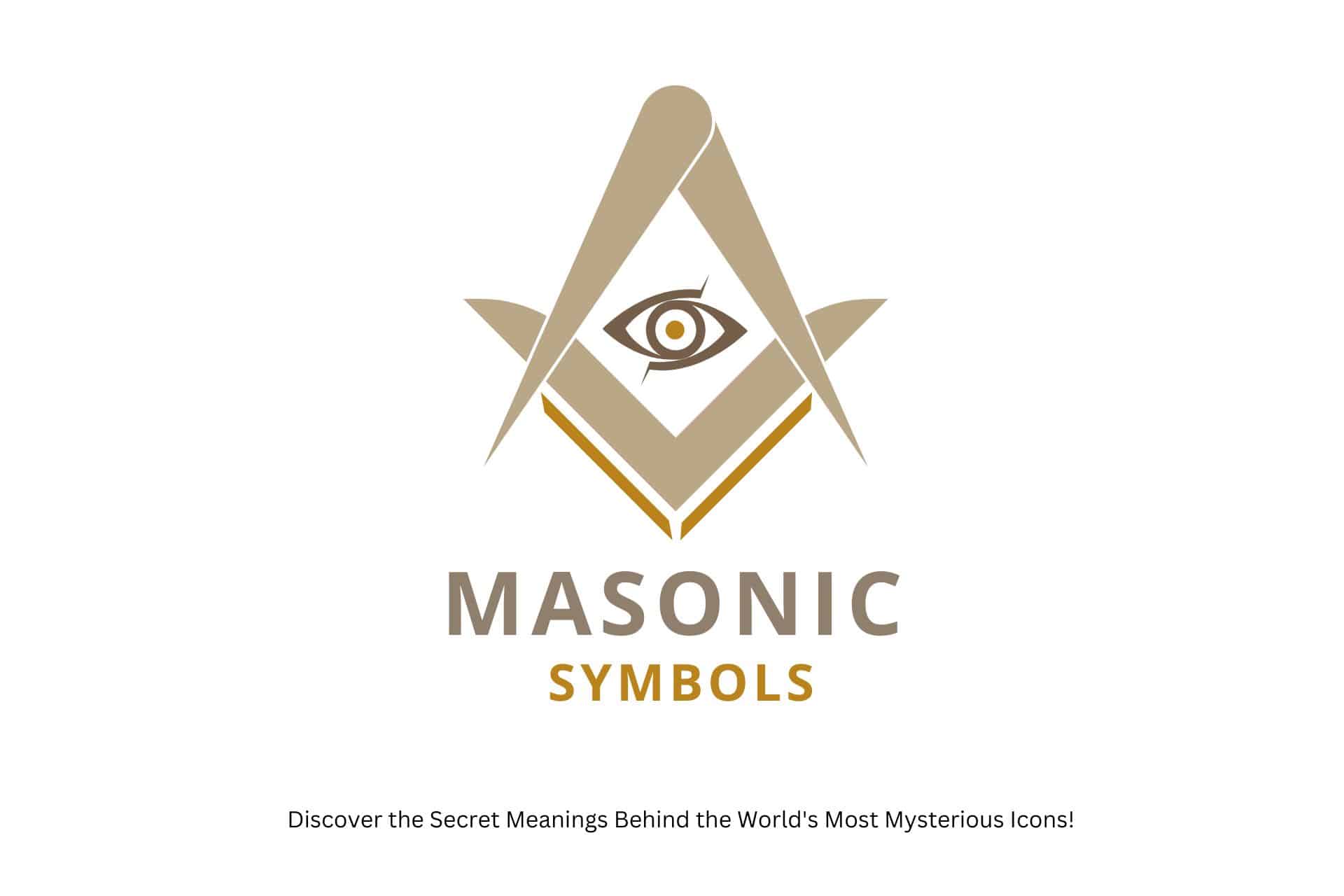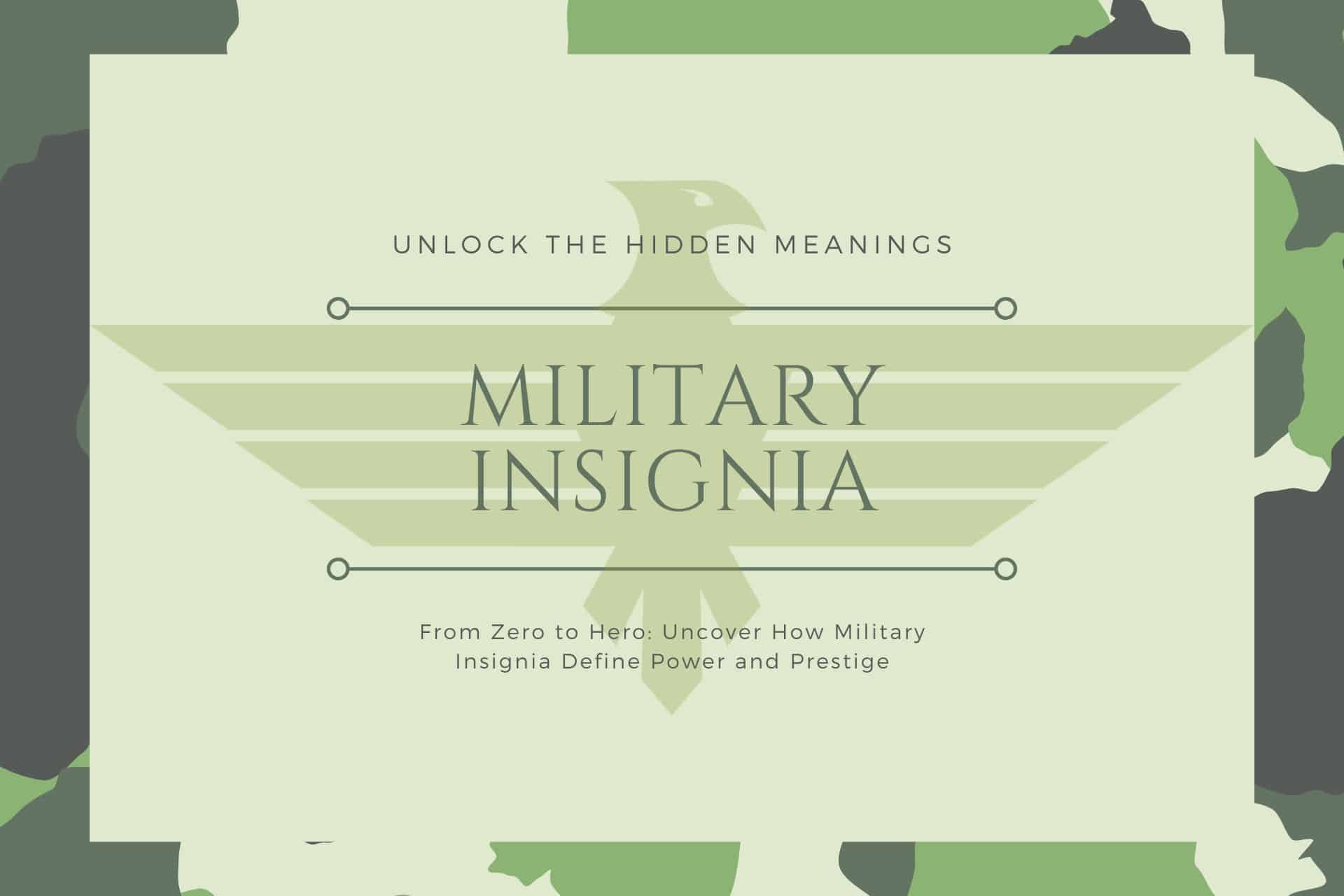Transform Your Understanding of Art and Discover the Magic Behind Artistic Symbols!
Are you curious about the meaning behind artistic symbols? Have you ever wondered about the stories these symbols tell or the emotions they convey?
This article is tailor-made for enthusiasts like you who are keen to unravel the mysteries of artistic symbols, including the widely recognized and the profoundly personal.
Don’t just admire the art—understand it. Learn about the cultural norms, historical events, and unique perspectives that these symbols reflect. Uncover the depth they add to an artwork and how they challenge our perceptions.
We promise to equip you with insights to enhance your art appreciation journey greatly.
Intrigued? Wonderful!
Continue reading to explore the fascinating world of artistic symbols and their impact on your art experience. —just an enriching journey through the world of artistic symbols and more.
Let’s get started!

Here’s What You Will Find

Key Takeaways
Artistic Symbols
Understanding Artistic Symbols: Artistic symbols are powerful tools used in different art forms to convey rich meanings, narratives, and the artist’s emotions.
Universality and Personal Significance of Symbols: Symbols in art can have universally recognized meanings or hold personal significance unique to the artist.
Interpreting Artistic Symbols: The interpretation of symbols in art involves understanding the context, the artist’s perspective, and personal interpretations, enhancing the subjective nature of art appreciation.
Historical Role of Symbols in Art: Symbols have played a critical role in art history, from early cave paintings to contemporary art, as they express and safeguard cultural narratives.
What is an Artistic Symbol?
An artistic symbol is a visual element used to represent ideas, concepts, or narratives beyond its literal appearance. These symbols can take various forms, such as objects, colors, shapes, figures, or even specific gestures, and they carry significant meanings or messages within a cultural, religious, or social context.
Artists employ symbols to convey deeper layers of meaning, evoke emotions, or provoke thought, allowing viewers to interpret the artwork beyond its surface value. For example, a dove may symbolize peace, a skull can represent mortality, and red might signify passion or danger.
By embedding complex messages into visual form, artistic symbols enrich the artwork, offering a bridge between the visible and the invisible, the material and the spiritual.
At its core, an artistic symbol is more than just a powerful tool artists use to convey complex concepts and emotions visually and concisely.
It transcends the boundary of a simple illustration or a literal representation, becoming a portal that ushers you into the artist’s world. It’s a conversation, a narrative, a shared experience that bridges the gap between the artist’s vision and the viewer’s perception.
Artistic Symbols
It’s important to understand that an artistic symbol isn’t merely a graphical depiction or a representational image. Instead, it serves as a gateway, a conduit through which the viewer can explore the artist’s world.
Artists can use symbols to profoundly and subtly share their visions, emotions, and thoughts. Each symbol carries a depth of meaning and a richness of narrative that can only be fully appreciated through an understanding and empathetic lens.
Symbols are found in various art forms, from paintings to sculptures, literature to music. They’re omnipresent, and their ubiquity is a testament to their fundamental role in artistic expression.
Symbols in Different Forms of Art
Artistic symbols manifest uniquely across different mediums, each employing specific elements to convey deeper meanings:
- Paintings use color palettes and motifs to evoke moods or themes.
- Sculptures leverage materials, shapes, and positioning to symbolize concepts.
- Literature employs imagery, allegory, and metaphor for layered meanings.
- Music uses rhythm, melody, and lyrics to express emotions or ideas.
Symbols range from universally recognized ones, like a heart symbolizing love, to personal symbols unique to the artist’s experiences.
Understanding Artistic Symbols
To truly grasp the meaning of artistic symbols, you must examine their context, consider the artist’s perspective, and reflect on your interpretations.
This journey isn’t just about understanding a visual element; it’s about engaging in a dialogue with the artist, the artwork, and yourself.
How to Decode Artistic Symbols
Understanding artistic symbols is a complex process that involves numerous factors, including cultural context, artist intent, and personal interpretation.
The journey of understanding artistic symbols is far from a casual stroll. It’s a profound exploration, where you’ll discover that symbols aren’t merely aesthetic or decorative facets. They’re potent communicative devices, teeming with layers of meaning. These symbols can elicit emotions, ignite thoughts, or narrate a tale.
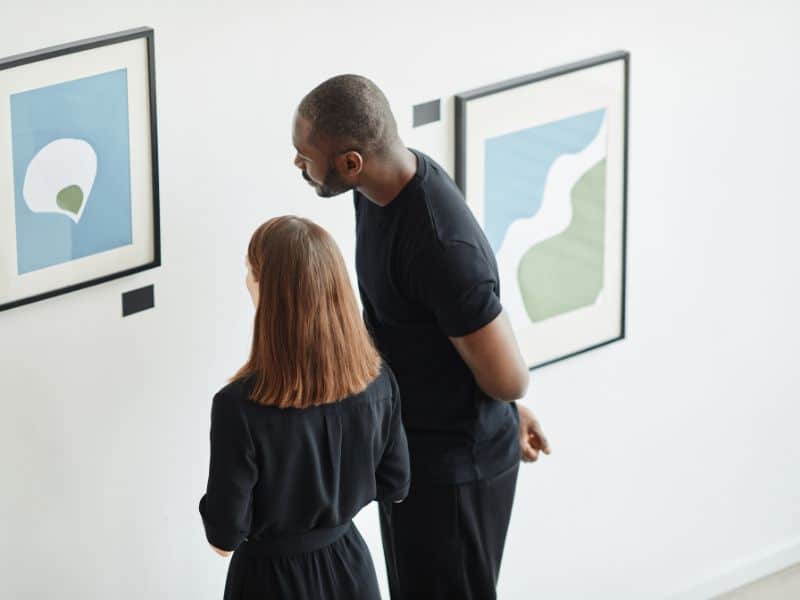
Understanding artistic symbols involves deeply understanding their context, the artist’s intent, and your interpretation. This rich exploration reveals symbols as more than mere decoration—they are powerful conduits of meaning, emotion, and narrative.
- Context: The artwork’s cultural background, era, and environment significantly influence the symbol’s meaning. For example, red might symbolize passion in Western cultures and luck in Eastern ones.
- Artist’s Perspective: An artist’s experiences, thoughts, and artistic influences shape how they use symbols. Learning about the artist’s life and themes in their work can provide valuable insights.
- Personal Interpretation: Your experiences and emotions contribute to how you interpret symbols, adding a subjective layer to their understanding.
This process is not just about recognizing symbols but engaging with them, offering a dialogue between you, the artist, and the artwork itself.
Unveiling the Visual Language of Art
Artistic symbols form an extensive and intricate visual language artists use to communicate more profound meanings, emotions, and concepts. From the universally recognizable to the profoundly personal symbols act as conduits between the artist’s intention and the observer’s perception.
Artistic symbols are categorized into three broad types: universal, cultural, and personal. Each type has distinct characteristics and significance.
Artistic symbols serve as the backbone of visual communication in art, offering diverse meanings and interpretations. They can be broadly categorized into three types, each with unique characteristics and significance in conveying deeper layers of meaning within an artwork.
Types of Artistic Symbols
Discover the rich diversity of artistic symbols: Universal symbols that speak a global language, cultural symbols that narrate the tales of specific societies, and personal symbols that offer a glimpse into the artist’s inner world.
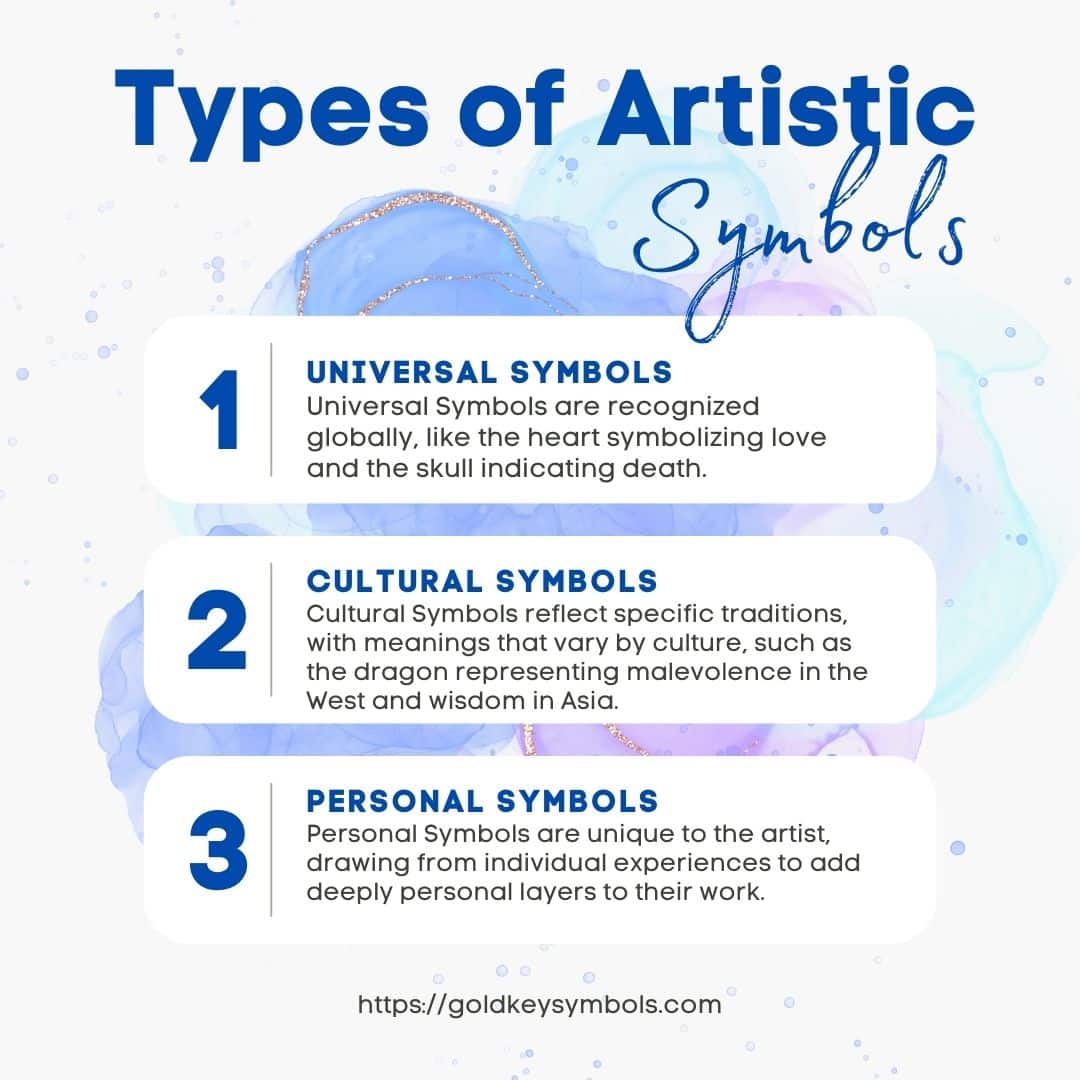
Universal Symbols:
- These symbols carry a widely accepted meaning across different cultures and societies.
- Examples include the heart as a symbol of love and the skull representing death or mortality.
- Their universal recognition allows them to convey clear and immediate messages to a broad audience.
Cultural Symbols:
- Cultural symbols are deeply rooted in specific societies’ traditions, beliefs, and history.
- They may vary significantly in meaning from one culture to another, reflecting each culture’s unique values and narratives.
- An example is the dragon, which may symbolize malevolence in Western cultures but wisdom and power in many Asian cultures.
Personal Symbols:
- These symbols are uniquely significant to the individual artist, often derived from personal experiences, emotions, or private narratives.
- They might not be immediately recognizable or meaningful to others without the context provided by the artist.
- Personal symbols allow artists to infuse their work with deeply personal layers of meaning.
Within these types, artistic symbols can be further classified into various categories, reflecting the richness of ideas represented in art and design.
- Color Symbolism: Harnessing the power of color to evoke specific emotions or cultural meanings. Red, for example, may symbolize passion or danger, while blue often evokes calmness or melancholy.
- Geometric Shapes: Utilizing primary geometric forms to symbolize fundamental concepts such as unity (circle), stability (square), and change or tension (triangle).
- Nature Symbols: Drawing from the natural world to embody complex meanings. Lions often denote courage, whereas lotus flowers might represent purity or spiritual awakening.
- Cultural and Religious Icons: Incorporate symbols from religious texts, myths, and cultural narratives. Examples include the Christian cross, the Hindu Om, and the Native American Thunderbird, each rooted in its tradition and story.
- Abstract Symbols: Employing non-representational forms to convey abstract concepts like love, freedom, or chaos, relying on the observer’s intuition and emotional response.
- Historical and Mythological Symbols: Referencing figures, events, or tales from history and mythology to imbue art with layered meanings. The phoenix, symbolizing rebirth or resurrection, is a prime example.
- Allegorical Symbols: Using symbols to represent broader ideas or principles, often found in Renaissance art. A blindfolded figure might stand for justice or the impartiality of law.
- Archetypal Symbols: These tap into universal symbols recognized across cultures, such as water, which symbolizes life, purification, or renewal and connects deeply with the human psyche.
- Text and Typography: This involves leveraging the aesthetic qualities of letters and text to convey specific messages or artistic expressions. The choice of font and arrangement can significantly impact the artwork’s meaning.
- National and Political Symbols: Flags and emblems, which identify nations, political movements, or patriotic sentiments, are often charged with a solid emotional weight.
- Personal Symbols: Unique symbols developed by artists to express personal themes or narratives, like Salvador Dalí’s iconic melting clocks, which recur throughout his work and offer a glimpse into his psyche.
- Movement and Style Symbols: These symbols identify specific art movements or styles, such as Cubism’s fragmented forms or Abstract Expressionism’s spontaneous expression, and reflect the philosophies and aesthetics of those movements.
- Body and Gesture Symbols: Using the human body and gestures to convey emotions or ideas, where body language becomes a powerful tool for expression within the artwork.
- Technological and Futuristic Symbols: These symbols represent modern technology, the future, or sci-fi concepts, often found in contemporary and digital art. They reflect societal hopes, fears, and dreams about technological progress.
- Occult and Esoteric Symbols: These symbols draw from occult, mystical, or esoteric traditions, such as alchemical symbols or tarot imagery, inviting viewers into a world of hidden meanings and ancient wisdom.
These categories showcase the diverse and multifaceted ways symbols are woven into the fabric of art, each carrying its unique vibrancy and depth.
Universal vs. Personal Symbols
In the rich tapestry of art, symbols play a pivotal role in conveying messages and emotions. Understanding the distinction between universal and personal symbols sheds light on their significance and impact:
- Universal Symbols are widely recognized across cultures and have shared meanings. For example, a dove typically symbolizes peace.
- Personal symbols are unique to an artist and hold specific, individual significance. These can represent personal memories, emotions, or concepts only the artist fully understands.
Uses of Artistic Symbols
Harnessing the power of artistic symbols, you can transform ordinary artwork into a compelling narrative, seamlessly blending aesthetics, meaning, and emotion.
How do you use symbols in art?
Symbols serve various purposes, enriching the artwork and providing deeper layers of meaning.
Here’s how symbols are commonly used in art:
- Conveying Complex Ideas: Symbols allow artists to express intricate concepts and abstract ideas in a visually digestible form, enabling viewers to grasp complex messages through a single image or motif.
- Evoking Emotions: Certain symbols are charged with emotional power and can evoke specific feelings in the viewer, ranging from love and hope to fear and despair.
- Representing Cultural and Historical Contexts: Symbols can anchor an artwork in a particular time and place, reflecting the cultural, social, and historical contexts that inform the piece.
- Communicating Universal Themes: Using universally recognized symbols, artists can communicate themes that resonate across different cultures and societies, such as life, death, and the human experience.
- Highlighting Political and Social Commentary: Symbols are often employed to critique, comment on, or advocate for political, social, and environmental issues, providing a powerful tool for social change.
- Exploring Personal Identity: Artists use symbols to explore and express aspects of their identity, including race, gender, sexuality, and spirituality. They invite viewers to reflect on their own identities about the work.
- Creating Visual Harmony and Rhythm: By repeating symbols, artists can develop a sense of harmony, balance, and rhythm within their work, guiding the viewer’s eye and enhancing the piece’s aesthetic appeal.
- Emphasizing Themes and Motifs: By repeating symbols throughout a piece or a body of work, artists can emphasize critical themes and motifs, reinforcing the artwork’s overall message and impact.
- Guiding Interpretation: Artists can use symbols to guide viewers toward a particular interpretation of a work, subtly suggesting how the piece should be understood while leaving room for personal reflection.
- Building Layers of Meaning: Symbols can add multiple layers of meaning to an artwork, inviting viewers to explore the piece and discover hidden messages and interpretations.
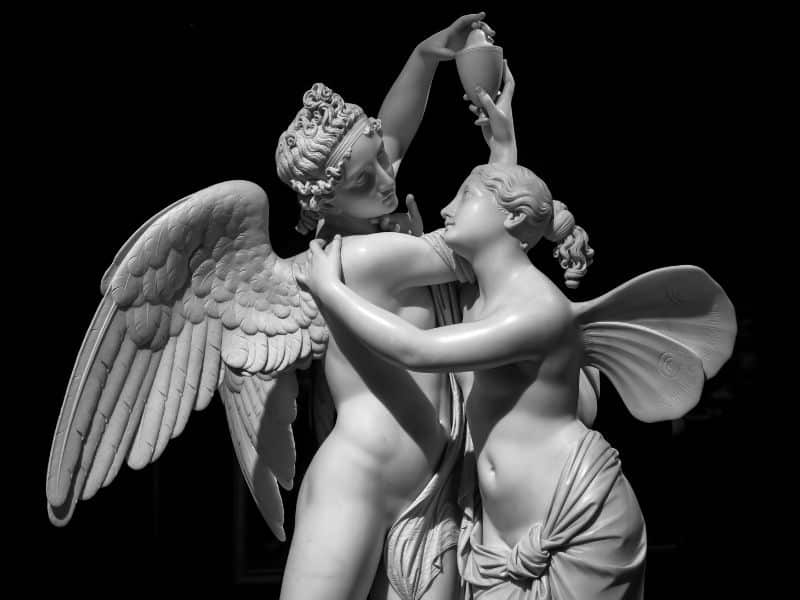
Artistic symbols are the visual language transcending cultural borders and time, communicating complex ideas with a universal appeal. These potent tools of expression add depth to your artwork and empower you to convey many emotions and themes.
Artistic Symbols Purpose
Artistic symbols can be employed to achieve several purposes.
Let’s explore these in detail:
- Expressing Emotions: Symbols can evoke a range of feelings, from joy and love to sorrow and anger, augmenting the emotional intensity of your artwork.
- Joy: Brightly colored symbols like flowers, sun, and butterflies often signify happiness and positivity. Using these symbols in your artwork can evoke feelings of joy and optimism.
- Love: Symbols like hearts, roses, or pairs of animals can be employed to express love. Such symbols stir up feelings of warmth, affection, and connection.
- Sorrow: Dark, heavy symbols, such as rain clouds, teardrops, or wilting flowers, can depict grief or pain and add emotional depth to your artwork.
- Anger: Symbols like fire, storm clouds, or jagged lines can convey anger or frustration, intensifying your work’s emotional impact.
- Conveying Ideas: Symbols can visually encapsulate complex philosophies or abstract ideas, enabling you to communicate effectively with your audience.
- Life and Death: The circle, or the ‘Ouroboros,’ symbolizes the cycle of life and death and encapsulates the philosophical idea of eternal return.
- Freedom: Birds soaring in the sky or broken chains are symbols often used to depict freedom or liberation.
- Peace: The dove or the peace sign are universally recognized symbols of peace and harmony.
- Creating Intrigue: Using symbols can add a layer of mystery to your artwork, inviting the viewer to explore and interpret your creative vision.
- Hidden Meanings: Lesser-known or personal symbols can create an element of intrigue, inviting viewers to explore the artwork further.
- Multiple Interpretations: Using ambiguous symbols that can be interpreted in various ways adds depth and complexity to the artwork and engages the viewer’s curiosity.
- Building Connection: Symbols often carry universal meanings, allowing your artwork to resonate with diverse audiences and foster empathy and understanding.
- Cultural Symbols: Employing universally recognized symbols helps establish a connection with a global audience.
- Personal Symbols: Using symbols that resonate with your experiences can create a deeper emotional connection with viewers who’ve had similar experiences.
Yet, the power of artistic symbols lies not merely in their usage but also in their interpretation. You can ascribe unique meanings to symbols that reflect your perspective as an artist.
Conversely, as a viewer, you can decode these symbols guided by your experiences and perception. This interplay between the artist and viewer makes artistic symbols a dynamic and potent tool for expression, fostering a dialogue that transcends the confines of spoken language.
Decoding Famous Artistic Symbols
Exploring renowned artistic symbols reveals their power to convey profound messages and evoke strong emotional and intellectual responses.
Artistic Symbols’ Impact
- Convey profound messages and evoke emotional and intellectual responses.
- Enrich art and deepen viewer engagement and interpretation.
Examples of Famous Artistic Symbols:
Picasso’s ‘Guernica’:
- The bull symbolizes political defiance.
- The horse represents chaos, mirroring the Spanish Civil War’s turmoil.
- Symbols rooted in Spanish culture amplify the painting’s critique.
Leonardo da Vinci’s ‘The Last Supper’:
- Apostles’ arrangement and gestures carry religious symbolism.
- Grouping into threes suggests the Holy Trinity.
- Judas’s gesture towards a bag of silver indicates betrayal.
- Bread and wine reference the Eucharist.
Hokusai’s ‘The Great Wave off Kanagawa’:
- Mighty wave contrasts with serene Mount Fuji.
- Symbolizes nature’s overwhelming force against human constructs.
- Offers commentary on the human condition and our natural world placement.
The Role of Symbols in Art
You may wonder why symbols are so paramount in the world of art. Symbols aren’t just a trivial embellishment; they’re the core of artistic expression, injecting profoundness and multilayered connotations into the fabric of creativity. Artists utilize these indispensable tools to encapsulate and convey their distinctive interpretations of our universe.

Symbols in art serve as an intermediary between the abstract and the concrete, bestowing form upon otherwise intangible emotions, concepts, and experiences. Through symbols, artists transpose the unseen into a universal language.
In a more detailed perspective, symbols can:
- Evoke profound emotions: Symbols, by their very nature, hold the power to provoke deep-seated feelings within us that we mightn’t even be aware of. They can stir emotions ranging from joy, sadness, fear, or even revulsion. This emotional connection that symbols can create is one of the reasons they’re so powerful in art. Symbols can bring to life feelings that words often can’t capture, giving the viewer a profound emotional connection with the artwork.
- Ignite thought-provoking reflections: Symbols can also challenge the viewer’s perceptions and beliefs, forcing them to question and analyze their understanding of the world. These symbols can lead us into a series of contemplations, pushing us to explore the art piece’s deeper meanings, thus instigating a mental dialogue between the viewer and the artwork.
- Facilitate a personal connection with the artwork: Symbols allow the viewer to experience the artwork on their terms, creating a unique interpretation that can vary significantly from one individual to another. This personal connection will enable viewers to engage with the artwork more intimately, giving them a sense of ownership and personal relevance.
- Provide a sense of liberation: Symbols can inspire viewers to break free from the shackles of literal interpretation, encouraging them to explore and embrace a more abstract understanding of the artwork. This sense of liberation can offer new insights and perspectives, allowing viewers to experience the artwork deeply, personally, and creatively.
When one looks at a painting, it’s not just a static image; it’s an invitation to embark on an exploration journey. This journey takes one deep into the artist’s psyche and confronts one with one’s truths. Symbols act as signposts on this journey, directing one’s understanding and influencing one’s emotional interaction with the artwork.
In essence, the role of symbols in art is to form a dialogue between the artwork and the viewer. They’re the language that artists use to transcribe their vision, and they’re the prism through which you, as a viewer, experience and translate that vision.
In art, as in life, symbols are the keys to a more profound comprehension and emotional resonance. They allow the viewer to explore the artwork, the artist’s intentions, the historical context, and the piece’s relevance.
History of Artistic Symbols
A Journey Through Time
The history of artistic symbols stretches back to the dawn of human civilization, beginning with the earliest cave paintings, where primitive symbols were used to communicate ideas, spiritual beliefs, and life experiences. These early representations, from the hunt scenes of Lascaux to the fertility goddesses of ancient cultures, laid the foundational language of symbols in art.
As civilizations evolved, symbolic imagery became more complex and diverse. Ancient Egypt’s hieroglyphs, for instance, were a sophisticated system of symbols conveying religious, cultural, and governmental narratives.
Similarly, Greek and Roman artists used mythological symbols to represent gods, heroes, and philosophical ideas in classical antiquity, embedding these symbols with cultural and moral significance.
The Middle Ages saw the rise of Christian symbolism in art, with countless symbols representing saints, virtues, and biblical stories designed to convey religious teachings to an illiterate populace. This period was marked by a rich tapestry of iconography, from the cross symbolizing Christ’s sacrifice to the lamb representing innocence and sacrifice.
With the Renaissance, there was a revival of interest in the symbolism of antiquity, enriched by a deeper exploration of perspective, human anatomy, and naturalism. Artists like Leonardo da Vinci and Michelangelo imbued their works with complex layers of meaning through symbolic references to mythology, religion, and science.
The modern era broadened the symbolic palette as artists sought to express the complexities of the human psyche, political ideologies, and existential queries. Symbols became more personal, abstract, and open to interpretation, reflecting artists’ diverse experiences and inner worlds across movements like Surrealism, Abstract Expressionism, and Pop Art.
Artistic symbols continue to evolve, reflecting global influences, technological advancements, and the shifting sands of culture and identity. From traditional mediums to digital art, symbols remain a vital tool for artists to express concepts, question societal norms, and connect with audiences on a profound level.
The history of artistic symbols is a testament to humanity’s enduring need to find meaning and connection through visual language.
Origin of Artistic Symbols
Artistic symbols, fundamental to human expression, trace their origins to the dawn of civilization, marking significant periods in history:
- Primitive Cave Paintings: Early humans used natural pigments to create simple yet profound depictions of communal life, hunting scenes, and animals in caves like Lascaux in France. Despite their simplicity, these images bore deep communal significance.
- Ancient Egyptian Hieroglyphics: This complex writing system used symbols to represent words, sounds, or concepts. It was crucial for recording Egypt’s history and culture, and the Rosetta Stone was key to deciphering these symbols.
- Native American Petroglyphs: Tribes created rock carvings to depict rituals and beliefs, with each tribe having unique symbols. New Mexico’s Petroglyph National Monument showcases over 20,000 such carvings.
- Ancient Greek Pottery: Functional yet expressive, Greek pottery featured intricate designs and motifs narrating tales from mythology and everyday life, spreading Greek culture through distinctive vase paintings.
These origins reflect the long history of artistic symbols as a core method for humans to communicate complex ideas and cultural narratives.
These symbols weren’t merely artistic expressions; they were tools of liberty, enabling societies to express, preserve, and pass on their unique narratives.
Studying these symbols isn’t just an exploration of art; it’s an unraveling of the tapestry of human expression and liberation. Each symbol, image, and pattern holds a story, a piece of the puzzle that makes up our shared human history.
Art Symbols Aesthetics, Interpretation, and Philosophy
Art symbols bridge the tangible and the intangible, embodying a universal language that transcends cultural and temporal boundaries. Rich in meaning and aesthetic value, these symbols augment our sensory experience and forge deep connections with the artist’s vision and the artwork’s cultural underpinnings.
The Aesthetic Appeal of Art Symbols
The visual allure of art symbols lies in their power to evoke emotions and provoke thought. They utilize elements like color, form, and composition to communicate beyond words.
The strategic use of symbols can create a sense of harmony or tension, guiding the viewer’s perception and eliciting a visceral response. This deliberate orchestration of visual elements underscores the artist’s ability to manipulate aesthetics to convey complex messages and evoke a deep emotional engagement.
Interpretation of Art Symbols
Interpreting art symbols is an intensely personal endeavor that weaves together the viewer’s experiences, cultural background, and emotional state with the historical and societal context of the artwork.
This dynamic interplay between the artwork and its audience highlights the subjectivity inherent in art interpretation, fostering a multifaceted dialogue that enriches our understanding and appreciation of art. In this way, art becomes a mirror reflecting the diversity of human experience and the complexity of our shared and individual identities.
The Philosophy of Art Symbols and Aesthetics
Exploring the philosophy of art symbols reveals how aesthetics and meaning coalesce to examine the essence of human experience.
Philosophers and artists grapple with questions about the nature of beauty, the purpose of art, and the role of symbols in bridging the gap between the sensory world and ideas. This philosophical inquiry challenges us to consider how art symbols represent reality and construct it, offering new perspectives on the familiar and inviting us to imagine the uncharted.
Art symbols become a conduit for existential exploration, questioning the foundations of our understanding and our place in the world. The aesthetic experience of art—rooted in the interplay of form, color, and symbol—transcends mere visual pleasure, prompting reflections on more profound questions of existence, identity, and the human condition.
Through this lens, art symbols are tools for expression and instruments of philosophical inquiry, probing the depths of what it means to be human.
Personal Interpretations vs. Intended Meanings in Art
The interaction between personal interpretations and an artist’s intended meanings often creates a dynamic tension in art. Viewers may bring their own experiences and emotions to their understanding of an artwork, which might not always match the artist’s original message.
Personal Interpretations
- Influenced by individual experiences and emotions.
- May associate symbols with personal meanings or memories.
- Subjective and can vary widely among viewers.
- Adds personal relevance and emotional depth to the artwork.
Artist Intentions
- Stem from the artist’s specific message or theme.
- Based on the artist’s experiences, thoughts, and creative goals.
- It can include symbolic, historical, or cultural references intended by the artist.
- Provides context and a deeper understanding of the artwork.
For instance, a sunflower painting could evoke joy and growth based on a viewer’s positive associations with the flower. Conversely, the artist might have intended it to symbolize false hope or fleeting joy, reflecting a period of personal despair.
This divergence doesn’t invalidate personal interpretations; it adds depth to the artwork, allowing it to be reinterpreted and remain relevant over time.
Similarly, understanding the artist’s intended meaning can enrich the viewer’s appreciation, offering insights into the artist’s emotions, thoughts, and creative process.
Cultural Influences on Art Symbols
Shifting our focus to the broader societal backdrop, the profound influence of culture on art symbols, shaping them and infusing them with varying degrees of meaning, can’t be overstated. Culture functions as an unseen force, shaping our perceptions, preferences, and the way we decipher symbols in art.

As you explore the world of artistic symbols, several aspects demonstrate the influence of culture:
Cultural Impact on Artistic Symbols
- Cultural Norms: Influence perceptions of beauty, the grotesque, and the taboo, thereby shaping art symbols. For instance, the dove symbolizes peace in Western cultures but may hold different meanings elsewhere.
- Beauty Standards: Vary across cultures, affecting art depictions. African cultures might celebrate larger body types as symbols of fertility, contrasting with Western preferences for slenderness.
- Historical Events: Lead to unique symbols with collective significance. The poppy flower, for example, symbolizes remembrance of World War I soldiers.
- Socio-economic Factors: Dictate symbols of wealth and power, which differ vastly across cultures, from luxury cars in Western societies to abundant crops or large families in others.
- Religious Beliefs: Inspire symbols with spiritual meanings, like the cross in Christianity or the lotus flower in Buddhism, which are deeply rooted in their respective religious contexts.
In Christianity, the cross is a potent symbol representing the crucifixion of Jesus Christ and the faith’s core beliefs.
In Buddhism, the lotus flower symbolizes purity and spiritual awakening, reflecting the religion’s focus on enlightenment. Hinduism uses the ‘Om’ symbol, representing the universe’s sound and the interconnectedness of existence.
Frequently Asked Questions
How are the golden arches of McDonald’s considered an artistic symbol?
McDonald’s golden arches are a globally recognized symbol. This iconic logo artistically represents the fast-food chain and demonstrates the power of branding and design in popular culture.
How do emojis serve as modern symbols in popular culture?
Emojis serve as modern symbols in popular culture by communicating emotions and ideas. They have become a new language in digital communication, proving the evolution and influence of artistic symbols in our daily lives.
How Do I Incorporate Artistic Symbols Into My Artwork?
To incorporate artistic symbols into your artwork, research symbols from different cultures and historical periods. Once you understand their meanings, you can align these symbols with your unique artistic message.
Are There Any Educational Programs or Workshops Specializing in the Study of Artistic Symbols?
Yes, some educational programs and workshops specialize in studying artistic symbols. These programs and workshops provide participants with in-depth knowledge and understanding of artistic symbols, empowering them to incorporate them creatively and effectively into their work.
How Have Digital Media and Technology Influenced the Use and Interpretation of Artistic Symbols?
Digital media and technology have revolutionized the use and interpretation of artistic symbols by expanding the toolkit available to artists. This has led to the creation of new symbolic forms.
What impact has the democratization of interpretation through digital media had?
The democratization of interpretation through digital media has allowed everyone to join the conversation, hence fostering a broader understanding of artistic symbols.
Can a Single Artistic Symbol Have Entirely Different Meanings in Different Cultures?
Yes, it is indeed true that a single artistic symbol can have markedly different meanings in various cultures. The cultural context significantly influences our interpretation, transforming a simple symbol into a complex cultural indicator.
Last Thoughts
Artistic symbols add depth, meaning, and intrigue to every work of art. They’ve evolved over centuries, influenced by culture and personal interpretations. Decoding these symbols can be a thrilling journey into the artist’s mind.
Remember, your interpretation may not always be what the artist intended, but that’s part of the beauty of art.
So, keep exploring and appreciating the fascinating world of artistic symbols. They genuinely enrich our understanding and appreciation of art.
Before You Go
We encourage you to share this article’s rich content with others. Spreading knowledge of artistic symbols can help deepen the understanding and appreciation of art worldwide.
After all, every interpretation adds a new layer of beauty to the artwork. So, help others embark on this thrilling journey into the minds of artists by sharing this article with your friends, family, and fellow art enthusiasts.
Check Other Artistic Symbols
- Color Symbolism
- Geometric Shapes
- Nature Symbols
- Cultural and Religious Icons
- Abstract Symbols
- Historical and Mythological Symbols
- Allegorical Symbols
- Archetypal Symbols
- Text and Typography
- National and Political Symbols
- Personal Symbols
- Movement and Style Symbols
- Body and Gesture Symbols
- Technological and Futuristic Symbols
- Occult and Esoteric Symbols
More on Symbols
History of Symbols: How Ancient Marks Shape Our Modern World!
From Cave Walls to Emojis—A Journey Through Time Have you ever wondered about the history of symbols? Maybe you’ve wondered about their global variations or how they’ve shaped our world. Prepare to have your curiosity …
Check it Out!Tattoos and Their Secret Powers: How Ink Can Change Your Life!
Exploring the Art, Meaning, and Culture of Ink! Are you intrigued by tattoos? Are you curious about the stories they tell and the intricate details they contain? Look no further. You might be wondering about …
Check it Out!Masonic Symbols Unlocked: Discover the Secret Meanings Behind the World’s Most Mysterious Icons!
The Hidden Powers and Ancient Secrets You Never Knew! Are you intrigued by masonic symbols and their profound meanings? Perhaps you’ve seen the square, compasses, or the all-seeing eye and wondered about their significance? Thankfully, …
Check it Out!Military Insignia: Unlock the Hidden Meanings Behind These Powerful Symbols
From Zero to Hero: Uncover How Military Insignia Define Power and Prestige Are you curious about the meaning behind military insignia or rank emblems? Have you ever wondered about their significance or history? This comprehensive …
Check it Out!More Symbols



